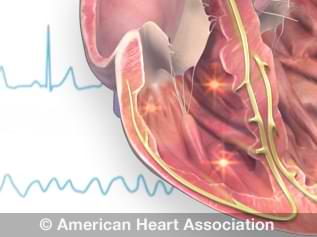Arrhythmias and Congenital Heart Disease
Quick Facts
- Congenital heart disease can change the heart’s rhythm.
- A health care professional can diagnose a heart rhythm problem.
- Treatment for an arrhythmia depends on the kind of problem and the patient’s needs.
How can congenital heart disease affect the heart’s rhythm?
When a person is born with congenital heart disease (CHD), one or more parts of the heart usually do not work correctly. Structural flaws, such as malformed valves or chamber walls, or surgical repairs, can change the heart’s rhythm.
Each heartbeat begins in an area of the right atrium called the sinoatrial (SA) node. The SA node starts each heartbeat by creating a small amount of electricity. That impulse spreads into the muscle cells of the atria, or the upper chambers. This causes the upper chambers to contract and push blood into the ventricles. If a chamber, valve, conduction tissue or repaired area is abnormal, it may cause an irregular heartbeat or affect the heart’s ability to pump effectively.
Next, the electrical impulse reaches the junction between the atria and ventricles. (The ventricles are the heart’s main pumping chambers.) This area is called the atrioventricular (A-V) node. The A-V node delays the impulse briefly so the ventricles have time to fill. Then the impulse passes into the ventricles, which causes them to contract. When the ventricles beat, they pump blood throughout the body. If valves or ventricles are affected by CHD, it can impair the heart’s ability to pump blood throughout the body.
How is a heart rhythm problem diagnosed?
Patients with structural or functional heart problems are at higher risk for heart rhythm problems. Patients who have had successful heart surgery are living longer. So, health care professionals are finding more heart rhythm problems among survivors.
A heart rhythm abnormality is evaluated the same way as other medical issues. Your health care professional will ask about your symptoms, such as a fast heartbeat, dizziness or fainting. Your CHD specialist or other health care professional can use several tests to diagnose an arrhythmia. The first is usually a Holter monitor or event recorder.
What is an arrhythmia?
An arrhythmia refers to abnormally fast or slow heart rates and to irregular heart rhythms.
A heart rate that’s faster than normal is called tachycardia. It can make the heart less able to pump blood effectively, and it may need treatment. Sometimes, tachycardia is due to a flaw of the heart’s electrical circuits. Other times, such as after surgery, it may be caused by higher levels of adrenaline, a stress hormone that makes the heart beat faster.
Medications known as beta-blockers, including propranolol or atenolol, can be used to prevent tachycardia or at least reduce the heart rate to prevent symptoms or problems.
Bradycardia is a heart rate that’s slower than normal. It may be related to some types of CHD or may develop after heart surgery. In some more serious cases and/or if the heart rate is very slow, an artificial pacemaker may be needed. Irregular beats or early (premature) heartbeats are often seen in normal infants and children. They may also be related to CHD or may happen after surgery. Irregular heartbeats without serious fast or slow rhythms usually don’t need treatment.
In adult patients with complex CHD and atrial arrhythmias, treatment through rhythm control is usually preferred over rate control. This is because of their unique anatomy and possible intolerance of rapid heart rates. Patients should talk to an adult CHD specialist or other health care professional about the best treatment option for them.






